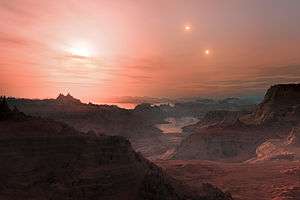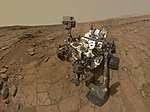(523662) 2012 MU2
(523662) 2012 MU2, provisional designation 2012 MU2, is a sub-kilometer asteroid on an eccentric orbit, classified as near-Earth object and potentially hazardous asteroid of the Apollo group.[2] It was discovered on 18 June 2012 by astronomers of the Catalina Sky Survey at an apparent magnitude of 19.9 using a 0.68-meter (27 in) Schmidt–Cassegrain telescope.[4] It has an estimated diameter of 240 meters (790 ft).[3] The asteroid was listed on Sentry Risk Table with a Torino Scale rating of 1 on 23 June 2012.[3]
| Discovery [1] | |
|---|---|
| Discovered by | Catalina Sky Srvy. |
| Discovery site | Catalina Stn. |
| Discovery date | 18 June 2012 |
| Designations | |
| (523662) 2012 MU2 | |
| 2012 MU2 | |
| Apollo · NEO · PHA [1][2] | |
| Orbital characteristics [2] | |
| Epoch 27 April 2019 (JD 2458600.5) | |
| Uncertainty parameter 0 | |
| Observation arc | 6.23 yr (2,277 d) |
| Aphelion | 3.1119 AU |
| Perihelion | 0.9987 AU |
| 2.0553 AU | |
| Eccentricity | 0.5141 |
| 2.95 yr (1,076 d) | |
| 114.89° | |
| 0° 20m 4.2s / day | |
| Inclination | 11.222° |
| 250.33° | |
| 16.587° | |
| Earth MOID | 0.0011 AU (0.43 LD) |
| Physical characteristics | |
Mean diameter | 240 m (est.)[3] |
| 20.8[1][2] | |
Orbit and classification
2012 MU2 is a member of the Apollo asteroids, a group of near-Earth objects with an Earth-crossing orbit. It orbits the Sun at a distance of 1.0–3.1 AU once every 2 years and 11 months (1,076 days; semi-major axis of 2.06 AU). Its orbit has an eccentricity of 0.51 and an inclination of 11° with respect to the ecliptic.[2]
On 24 June 2012 with an observation arc of 6 days, 2012 MU2 showed a 1 in 7,140 chance of impacting Earth on 1 June 2015. It was removed from the Sentry Risk Table on the next day (25 June).[5]
With an observation arc of 113 days, the JPL Small-Body Database (solution JPL 42 dated 2013-Aug-05) shows that 2012 MU2 may make a very close approach to asteroid 29 Amphitrite on 8 April 2179.[6] The minimum approach distance is about 0.000032 AU (4,800 km; 3,000 mi), but the maximum distance is 0.14 AU (21,000,000 km; 13,000,000 mi).[6] The nominal approach is 0.047 AU (7,000,000 km; 4,400,000 mi).[6]
The Earth approach in 2015 occurred on 15 May 2015 at a distance of 0.11485 AU (17,181,000 km; 10,676,000 mi).[6]
Numbering and naming
This minor planet was numbered by the Minor Planet Center on 25 September 2018 (M.P.C. 111778).[7] As of 2018, it has not been named.[1]
References
- "523662 (2012 MU2)". Minor Planet Center. Retrieved 9 October 2018.
- "JPL Small-Body Database Browser: 523662 (2012 MU2)" (2018-09-12 last obs.). Jet Propulsion Laboratory. Retrieved 9 October 2018.
- "Observations of small Solar-System bodies (2012 MU2)". hohmanntransfer. 23 June 2012. Retrieved 8 September 2013.
- "MPEC 2012-M24 : 2012 MU2". IAU Minor Planet Center. 20 June 2012. Retrieved 8 September 2013. (K12M02U)
- "Date/Time Removed". NASA/JPL Near-Earth Object Program Office. Retrieved 8 September 2013.
- "JPL Close-Approach Data: (2012 MU2)" (last observation: 2015-06-14; arc: 1091 days). Retrieved 3 July 2015.
- "MPC/MPO/MPS Archive". Minor Planet Center. Retrieved 9 October 2018.
External links
- List of the Potentially Hazardous Asteroids (PHAs), Minor Planet Center
- Discovery Circumstances: Numbered Minor Planets (520001)-(525000) – Minor Planet Center
- (523662) 2012 MU2 at AstDyS-2, Asteroids—Dynamic Site
- (523662) 2012 MU2 at the JPL Small-Body Database



